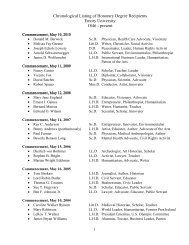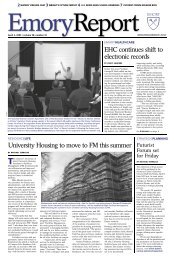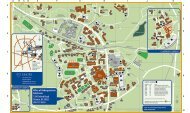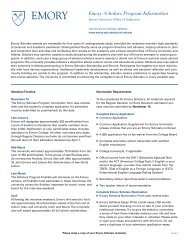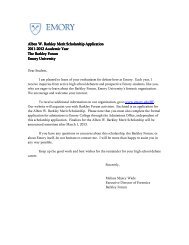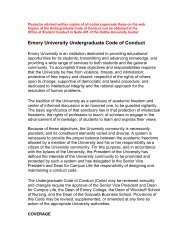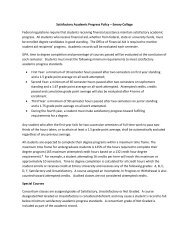DOSY Experiments - Emory University
DOSY Experiments - Emory University
DOSY Experiments - Emory University
You also want an ePaper? Increase the reach of your titles
YUMPU automatically turns print PDFs into web optimized ePapers that Google loves.
nugflag<br />
nugcal_[1-5]<br />
dosyproc<br />
dosybypoints<br />
'n' uses simple mono- or multi-exponential fitting to estimate<br />
diffusion coefficients<br />
'y' uses a modified Stejskal-Tanner equation in which the exponent<br />
is replaced by a power series.<br />
a 5-membered parameter array summarizing the results of the<br />
calibration of non-uniform field gradients. Used if nugflag='y',<br />
requires a preliminary NUG-calibration by the Doneshot_nugmap<br />
sequence. The values are taken from the probe file at the time of<br />
the data acquisition<br />
'discrete' - invokes monoexponential fitting with dosyfit if ncomp=1,<br />
and multiexponential fitting with the external programme SPLMOD<br />
if ncomp>1.<br />
'continuous' invokes processing with the external programme<br />
CONTIN and gives a continuous distribution in the diffusion<br />
domain.<br />
'n' divides the spectrum into individual peaks, creating one crosspeak<br />
for each individual peak found in the 1D spectrum<br />
'y' performs a diffusion fit for every point in the displayed region of<br />
the spectrum that lies above the selected threshold.<br />
4.4 Convection and Convection-Compensation in Diffusion<br />
<strong>Experiments</strong><br />
Convection within the sample tube can seriously affect diffusion experiments, in particular at<br />
elevated temperatures. Convection currents are caused by small temperature gradients in the<br />
sample and result in additional signal decay that can be mistaken for faster diffusion.<br />
The convection conditions are described by the Rayleigh-Bénard equation:<br />
R a<br />
gβR<br />
∂T<br />
=<br />
νχ<br />
∂z<br />
4<br />
Ra = 67 for insulating walls<br />
Ra = 216 for conducting<br />
where g is the gravitational acceleration, ν is the viscosity, χ the thermal diffusivity, β the<br />
expansion coefficient of the liquid, R the internal diameter of the NMR tube and ∂T/∂z the<br />
temperature gradient along the sample axis. When the critical Rayleigh number (Ra) is exceeded<br />
convection will occur. Convection typically causes the following anomalies in diffusion<br />
experiments:<br />
Anomalously large diffusion coefficients (D)<br />
D values that are not independent of gradient duration (δ) and the diffusion delay (del)<br />
Stejskal-Tanner plots that show periodicity<br />
Irregular (non-Arrhenius) temperature dependence of D<br />
A simple calculation based on the Rayleigh-Bénard equation indicates that, for a solvent like<br />
chloroform, a temperature gradient of as little as 0.05 K/cm is sufficient to cause convection flow.<br />
In general, larger temperature gradients are needed for more viscous solvents.<br />
In a typical <strong>DOSY</strong> experiment, a uniform sample flow velocity v introduces a phase modulation of<br />
the signal:<br />
S zi<br />
2 2 2<br />
G ⎟<br />
⎞ zi = S(<br />
0)<br />
exp( −Diγ<br />
δ ( Gzi)<br />
Δ)<br />
* exp( iγδG<br />
Δ))<br />
⎜<br />
⎛ v<br />
⎝ ⎠<br />
32






